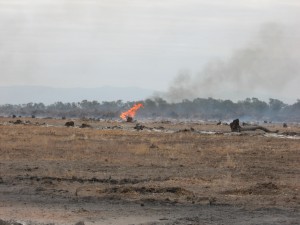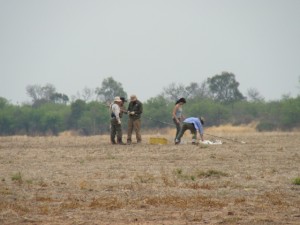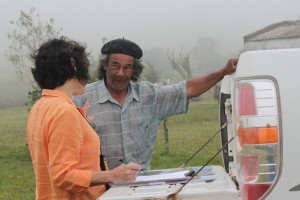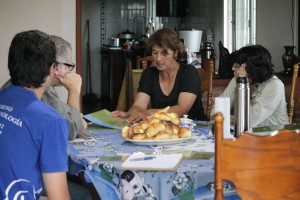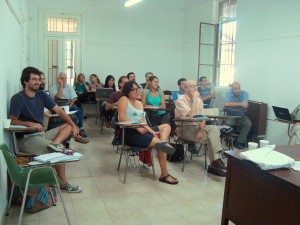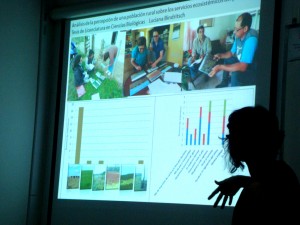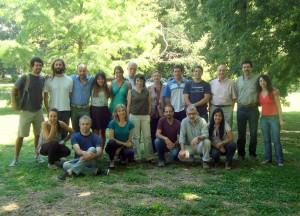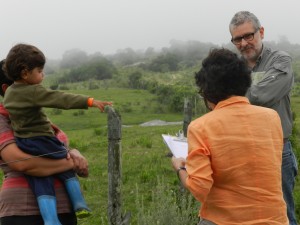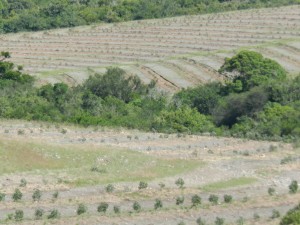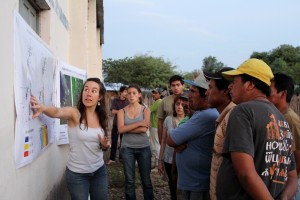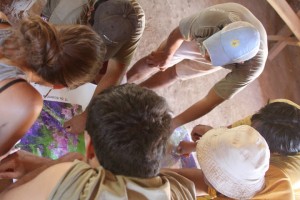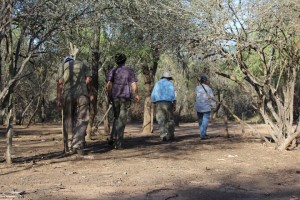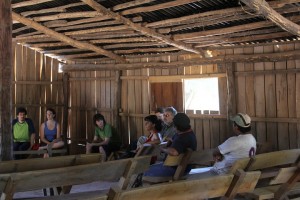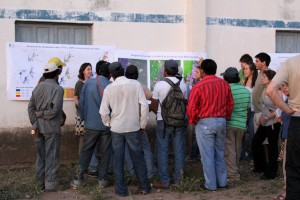BEST-P: Bridging ecosystem services and territorial planning, a southern South American initiative (CRN 3095)

Project information
LART-IFEVA, Facultad de Agronomía & CONICET, Argentina
Project brief: Production and/or conservation?
Results Functional types Project outreach Project investigators Students Executive Summary Photos
Results
This is a summary of the most salient project results. For further information see the project website, project papers or contact the investigators directly.
Following the description of groundwater recharge and soil salinization in the semiarid Chaco, field studies (Cl- profiles, water content, pH and electric conductivity to 6 m depth) showed the positive influence of forest patches on the drainage of agricultural fields. Spatial analysis is now used to suggest landscape configurations that can minimize groundwater recharge at a given ratio of forests/crop lands.
For this, the team is compiling a data on the dynamics of land cover for the past 40 years, analyzing cells of 6000 ha for a total of 2851 cells over the whole area. Remote-sensed spatial quantification of evapotranspiration will relate water balance to landscape configuration including different land cover types and their water consumption, as estimated from Landsat-derived evapotranspiration. ET transects crossing borders between forests and more than 25-year-old crop lands will be analyzed using NOAA’s AVHRR to generate weekly estimates since 2003 for the whole region.
The monitoring identified land uses/covers where management interventions are needed. ET of afforested areas was 22% higher than that typical of grasslands (2.5 mm/day) and afforestation reduced water yield in the micro-watershed analyzed by 5.4 %.
The team completed the calibration of the Century model for the Chaco region. As in the Great Plains, the model simulated soil organic carbon C in biomass and yield accurately. Simulations showed that the replacement of forest by annual crops generated a loss of 66 Mg C/ha from the aboveground biomass a 40% loss of C from the top 1m of soil. Such soil C losses adversely affected ecosystem services like climate and water regulation, and erosion protection.
More detailed description of land cover in terms of Ecosystem Functional Types – identified from the Advanced Very High Resolution Radiometer (AVHRR), available for 1981-present at a resolution of approximately 16 km, was initiated to obtain a consistent set of biophysical properties and estimated net primary production for each EFT.
A refined NDVI, to estimate Net Primary Production (NPP) from photosynthetically active radiation absorbed (APAR), provided high accuracy estimates of the herbaceous production even under the canopy of forests. It is an important achievement developed in consultation with ranchers to provide forage production estimates in silvopastoral systems to ranchers and decision makers.
Grazing has an important role in regulating both stock and dynamics of C in grassland ecosystems: below-ground biomass was higher in grazed (1400 g/m2) than in ungrazed (950 g/m2) areas while turnover rates were similar.
Water harvesting infrastructure was more common and elaborate in Paraguay than in Argentina (1 vs. 0.1 per km2). Paraguay is harvesting near 5 mm/year of rainfall, mostly on pastures, whereas Argentina less than 0.5 mm/year, mostly in forests.
The annual integral of NDVI and its intra-annual coefficient of variation explain 65- 90% of the spatial variability of 4 ecosystem services: soil organic C sequestration, groundwater recharge, hydrologic yield and avian biodiversity as measured in the field or modeled by CENTURY for the Chaco-Pampean plains.
A database of deforestation for the whole Chaco (787,000 km2, spanning 1976-2013) was completed in collaboration with INTA and REDAF, based on visual interpretation LANDSAT images. Maps were generated for Argentina, Uruguay, Bolivia and Paraguay with a resolution of 1×1 km.
The analysis of 14 groups of land users of local or foreign origin, individuals or corporations, dedicated to pasture and/or crop production over the whole Chaco combined with 12 years of MODIS-NDVI data showed non-significant differences in primary production but strong contrasts in seasonality and long-term variability, including 4-fold differences in the rates of vegetation greening and browning, differences in growing period length (190 to 280 days y-1), crops per year (1- 1.75), and inter-annual variation. More capitalized groups had very large field sizes, less stable productivity patterns, and more divergent seasonality. Smallholders showed more stable productivities both seasonally and inter-annually.
The group of “productivist” landholders favored deforestation for pasture cultivation, despite observations that conservation outcomes can increase 30-50% without significantly reducing productivity by transitioning towards a multifunctional regime. A willingness to conserve forests existed in pre-productivist landholders, indicating the potential of an endogenously motivated transition towards a multifunctional landuse regime, which may increase productivity by 35-65% without compromising avian habitat. Promoting this transition will require exogenous incentives and regulations tailored to the behavior of this landowner group. Interviews were used to define additional valued ES, from tourism attractions to support for bee keeping, and resource an Inter-cultural Medicine Program.
Several projects make information directly available to stakeholders. This one goes further in custom tailoring the transfer and replacing expensive software requirements with open source facilities. To better cater to the demand side of the project, benefits from ecosystem services are being conceptually and methodologically disaggregated a) between direct benefits (those mostly depending on spatial patterns of propagation and capture of biophysical flows) vs. indirect benefits (those depending on money circuits), and b) among main social sectors (according to stakeholders and economic sectors). The mapping of ecosystem functions -services- benefits and the social responses of sensibility, exposure, adaptive capacity which translate into vulnerabilities under landuse change are integrated using a web-based tool box and mapped, initially using arcGIS, and now using the open source QGIS.
Following contacts between project researchers and the national Ombudsman (Defensoría del Pueblo) of Argentina a research line was reformulated to show that deforestation in one province has consequences on the climate of another. This critical piece of evidence permits moving trials on illegal deforestation from provincial to federal courts. Such changes would increase the transparency of the implementation phase of the Native Forests Act of Argentina.
Functional types of social ecosystems: an alternative for territory zoning for planning and ordering processes
Director: PARUELO, José
LART-IFEVA-Facultad de Agronomía and CONICET
Mapping and characterizing ecosystem processes and their linkages with the actors operating on the field are key inputs ecosystem-based land analysis and planning. The spatialization of characteristics associated to the human dimension is scarce and there is practically no integration of the biophysical and human aspects. The objective of this project is to develop a methodology that would combine different attributes of the human and biophysical dimensions when identifying and mapping Functional Types of Social-ecosystems in grasslands of the Río de la Plata and the semiarid Chaco, that would lead to zoning according to observed or potential aptitudes and impacts of human activity that are useful to land planning.
Project outreach
In a dry region in which surface water course were unknown, new rivers started to appear. In just three decades tiny streams mutated into permanent brackish water currents that carve enormous valleys and bury fields, buildings and livestock. Water and mud are threatening the closest town and social unrest grows. Why is this happening? Why here? Why now? Settlers and scientists exchange their disconcert and search for explanations. Nature gives its own version of the facts, returning questions to the people. Can the current agricultural expansion be sustained? What human conflicts does it bring? This documentary was produced jointly with CRN 3095Now with English subtitles!
The documentary shows the territory of southern Chile and aims at understanding the relationship of indigenous communities with forest and water ecosystems. It addresses cultural and environmental losses that occur every day as strong impact extractive processes continue, and the active role of local communities around governance for well-being.
Project investigators
José M. Paruelo (paruelo@agro.uba.ar)
LART-IFEVA, Facultad de Agronomía & CONICET, Argentina
Pedro Laterra (platerra@balcarce.inta.gov.ar)
Universidad Nacional de Mar del Plata, Argentina
Antonio Lara (antoniolara@uach.cl)
Universidad Austral de Chile, Chile
Laura Nahuelhual (laura.nahuel@gmail.com)
Universidad Austral de Chile, Chile
Alice Altesor (aaltesor@fcien.edu.uy)
Universidad de la República, Uruguay
Verônica Filardo (filardo.veronica@gmail.com)
Universidad de la República, Uruguay
Hugo Berbery (berbery@atmos.umd.edu)
University of Maryland, USA
Gerardo Bocco (gbocco@ciga.unam.mx)
Universidad Nacional Autónoma de México, Mexico
Students
Alejandra Auer, PHD, Universidad Nacional de Mar del Plata, Argentina.
Andrea Geymonat, Master, Universidad de la República, Uruguay.
Camilo Bagnato, PHD, LART-UBA, Argentina.
Carla Rueda, PHD, Grupo de Estudios Ambientales, Argentina.
Carol Perugache Rodríguez, Master, Universidad Austral de Chile, Chile.
Claudia Tapia Friz, Master, Universidad Austral de Chile, Chile.
Costanza Caride, PHD, LART-UBA, Argentina.
Daniel Villarroel Torrez, Undergraduate, Universidad de Buenos Aires, Argentina
Danilo Carnelos, PHD, Universidad de Buenos Aires, Argentina.
Eva Florio, PHD, Grupo de Estudios Ambientales, Argentina.
Fabio Trinco, Undergraduate, Universidad de Buenos Aires, Argentina.
Federico Gallego, PHD, Universidad de la República, Uruguay.
Federico Weyland, Post Doctorate, Universidad Nacional de Mar del Plata, Argentina.
Felipe Benra, Undergraduate, Universidad Austral de Chile, Chile.
Felipe Gallego, Master, Universidad de la República, Uruguay.
Felipe Hasen, Master, Universidad Austral de Chile, Chile.
Florencia Rositano, Post Doctorate, Universidad de Buenos Aires, Argentina.
Francisco Murray, PHD, Grupo de Estudios Ambientales, Argentina.
Gabriela Martínez, Undergraduate, Universidad de la República, Uruguay.
Gonzalo Camba Sans, Undergraduate, Universidad de Buenos Aires, Argentina.
Hernán Dieguez, PHD, LART-UBA, Argentina.
Ignacio Díaz, PHD, Universidad Austral de Chile, Chile.
José Barrena, PHD, Universidad Austral de Chile, Chile.
Jose Volante, PHD, INTA, Argentina.
Laura Amdan , PHD, LART-UBA, Argentina.
Leandro Sgroi, PHD, Universidad Nacional del Litoral, Argentina.
Lisandro Blanco, PHD, INTA, Argentina.
Luciana Bindritsch, Undergraduate, Universidad de la República, Uruguay.
Manuel Martínez, Undergraduate, Universidad de la República, Uruguay.
María Agostina Bracalenti, Undergraduate, Universidad Nacional del Litoral, Argentina.
María Basualdo, PHD, LART-UBA, Argentina.
María Fernanda de Torres, PHD, Universidad de la República, Uruguay.
María Vallejos, PHD, LART-UBA, Argentina.
Matias Mastrángelo, PHD, Universidad Nacional de Mar del Plata, Argentina.
Nestor Burgos, Master, Universidad Austral de Chile, Chile.
Omar Muller, PHD, Universidad Nacional del Litoral, Argentina.
Pablo Baldassini, Master, LART-UBA, Argentina.
Pablo Vernal, Master, Universidad Austral de Chile, Chile.
Patricio Magliano, PHD, Grupo de Estudios Ambientales, Argentina.
Paula Barral, PHD, Universidad Nacional de Mar del Plata, Argentina.
Priscila Pinto, PHD, CONICET, Argentina.
Raul Gimenez, PHD, Grupo de Estudios Ambientales, Argentina.
Renard Bentancourt, Master, Universidad Austral de Chile, Chile.
Santiago Baeza, PHD, Universidad de la República, Uruguay.
Sebastian Aguiar, PHD, LART-UBA, Argentina.
Sebastian Villarino, PHD, Universidad Nacional de Mar del Plata, Argentina.
Tomás Della Chiesa, PHD, CONICET, Argentina.
Victor Borrás Ramos, PHD, Universidad de la República, Uruguay.
Ximena Vergara, Master, Universidad Austral de Chile, Chile.
Executive Summary
Territorial planning of land use is an urgent need in southern South America. The area cultivated with soybean, and Eucalyptus and Pinus, is expanding at increasing rates in both grasslands and forests of Argentina, Chile, Uruguay, Paraguay, and Bolivia. Territorial disputes motivated by land use changes have affected basic human rights of peasants and aboriginal people. Throughout southern South America, the costs and benefits of this land transformation for the different stakeholders are poorly characterized, and the benefits are not available to the most vulnerable social sectors. The main goal of our project is to make operational the concept of Ecosystem Services (ES) for land use planning in southern South America We will focus on landscapes of the Rio de la Plata Grasslands of Argentina and Uruguay, the dry-forests of the Gran Chaco (Argentina, Paraguay and Bolivia), and the Valdivian forests of south-central Chile.
In this project, we will emphasize ecosystem aspects related to: (a) carbon dynamics (e.g. Net Primary Production, C stocks and losses, carbon released by fires); (b) water (e.g. evapotranspiration, hydrological yield and quality); (c) climate regulation; (d) trace gas (e.g. NOx) emissions; and (e) type and distribution of habitats (e.g. landscape structure and configuration). For some specific landscapes, we will also analyze the potential for recovery of ES through the restoration of ecosystems and landscapes that have been impaired or degraded.
ES supply will be evaluated in a spatially explicit manner, by describing the ecosystem processes that support ecosystem services with relative (unit-less) ES values, and based on the assessment of ES vulnerability according to ES delivery (social capture and distribution) and ecosystem recovery after agricultural replacement. For the landscapes to be selected in each of the three regions, we will develop specific ES production functions according to the characteristics of the Socio-Ecological Systems. We will characterize the past and current distribution of Land Use and Land Cover (LULC) types for the landscapes to be analyzed and their regional context. An important part of the project will be the analyses of stakeholders and of the governance in each of the landscapes.
A team of 23 researchers from 9 institutions and 5 countries will merge their complementary backgrounds, generating novel insights on ES theory and on the application of the ES framework for territorial planning. The project includes an important component of capacity building through training programs oriented to both the professional sectors and to local stake-holders. The existing partnership with government agencies, NGOs, the private sector, and other stakeholders provide the basis for dissemination and application of the results of the project. At the end of the project we hope to have: a) a better understanding of the effect of functional and structural diversity of landscapes on the provision of ES, b) a comprehension of the effect of social and cultural capital on ES supply and demand in the different landscapes studied, c) impact and production functions for key intermediate and final services for the three regions under study, d) toolboxes that allow an effective integration of the ES paradigm into territorial planning and, e) a greater capacity to influence territorial planning processes through trained agents and stakeholders. Peer review articles on the more basic aspects of our agenda, a synthesis book, regional meetings and workshops, and an established program to train professional agents and stakeholders will be the objective indicators of the level of achievement of our goals.
Photos
